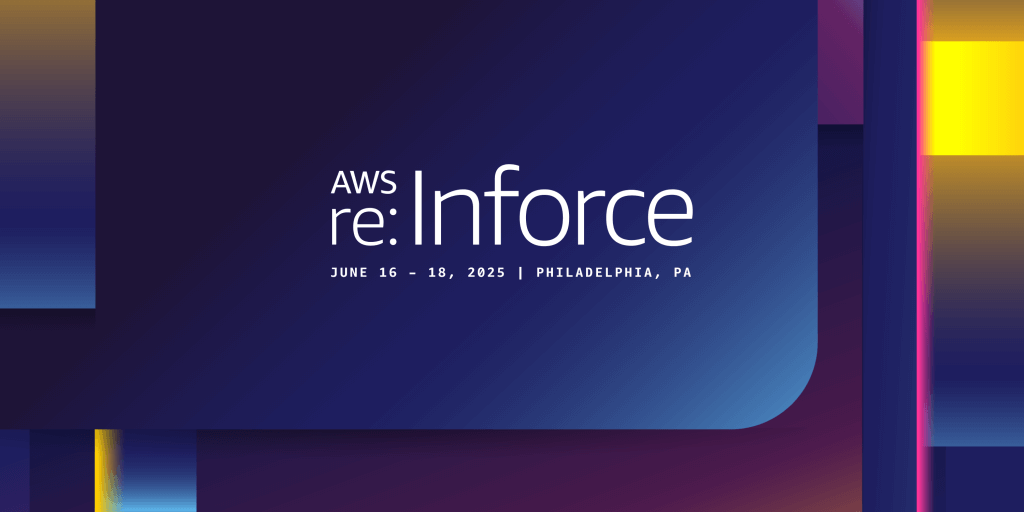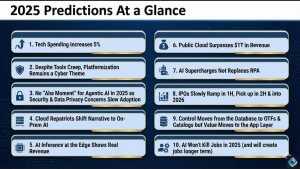Navigating Innovation, Partnership, and the Evolving Cloud Security Landscape

In Philly this week, AWS re:Inforce 2025 offered a compelling, if complex, view into Amazon’s strategic direction. The conference showcased AWS’s continued innovation in core security services, reinforcing its commitment to providing robust native capabilities for its vast customer base.
Amazon demonstrated a clear focus on using customer feedback, as well as AWS’ own experience protecting itself, to deliver insight and action. Customers are growing increasingly frustrated with an endless stream of alerts of questionable veracity and have long been demanding more resources to prioritize issues and guidance on next best actions. AWS showcased a number of tools and capabilities to address exactly these issues.
However, beneath the surface of new feature announcements lay a persistent and increasingly critical strategic challenge for AWS: how to advance its own security offerings without inadvertently encroaching upon or disincentivizing its crucial SaaS security partner ecosystem. This is not unique to Amazon in any way, Microsoft has faced similar challenges. AWS’s tightrope walk was a subtle but discernible undercurrent throughout the event. While new announcements were met with characteristic enthusiasm, the long-term implications for independent software vendors specializing in cloud security (many of whom build exclusively on or deeply integrate with AWS) warrant closer scrutiny on the partner side and necessitate clearer messaging on Amazon’s behalf.
Analyzing the Core Announcements: A Step Towards Greater Native Control
The key announcements from re:Inforce 2025 largely focused on strengthening foundational security controls, making best practices easier to find, understand, and implement, and pushing security further left in the development lifecycle. These are logical and necessary advancements given the escalating scale and sophistication of cloud-native threats, as well as the AI-powered scope creep of most security teams.
The enhanced capabilities of AWS Identity and Access Management (IAM) Access Analyzer to provide organizational-level insights into resource access represents a significant step towards centralized governance. Through a process AWS calls automated reasoning, Access Analyzer can evaluate service control, resource control, and identity policies to determine which roles and users have access to critical assets. For large enterprises, this offers improved visibility into access policies across numerous accounts, potentially streamlining compliance efforts and reducing the attack surface.
From an analytical perspective, this development suggests AWS is continually refining its native tooling to address the complexities of managing identity and access at an organizational scale, a common pain point for customers. While beneficial for customers, this also means AWS is taking on more responsibility for areas previously often handled by third-party IAM governance solutions or custom scripting.
The mandatory enforcement of Multi-Factor Authentication (MFA) for root users across all account types is a long-overdue security hygiene measure, as root account compromise remains a severe risk, and mandating MFA directly mitigates this critical vulnerability. This move underscores AWS’s commitment to baseline security hardening, effectively offloading a fundamental security responsibility from the customer to a more enforced posture by the cloud provider. It’s a non-controversial, net-positive move for overall cloud security.
Perhaps the most impactful technical announcement was the general availability of Amazon Inspector’s code security capabilities. This allows for the identification of vulnerabilities and misconfigurations within application source code and infrastructure as code (IaC) before deployment. This “shift-left” strategy is critical for modern CI/CD pipelines, enabling developers to integrate security earlier and remediate issues more cost-effectively. From an analyst’s viewpoint, this positions Amazon Inspector more directly as a competitor to existing static application security testing (SAST) and IaC security scanning tools from various security vendors. While AWS will likely frame this as a foundational offering, its continuous expansion into application security testing signals a broader ambition to cover more of the development lifecycle natively.
Beyond these specific features, the ongoing evolution of services like Amazon GuardDuty for threat detection and AWS Shield for DDoS protection also featured in conference discussions, signaling a continued investment in a comprehensive, automated, and intelligent security fabric within the AWS ecosystem.
The Edge Factor: ACM Exportable Certificates and the Hybrid Cloud Imperative
Beyond the core security announcements, another development at re:Inforce 2025, or perhaps highlighted in its broader context, deserves particular attention: the introduction of AWS Certificate Manager (ACM) exportable public SSL/TLS certificates. While seemingly a niche feature, its strategic implications are considerable, potentially signaling AWS’s anticipation of a significant shift in enterprise cloud adoption, particularly driven by emerging AI workloads.
Traditionally, ACM managed certificates were largely confined to AWS services, abstracting away the complexities of key management and renewal. The ability to now issue public certificates via ACM, gain access to their private keys, and deploy them on any workload, be it Amazon EC2, containers, or critically, on-premises hosts, marks a subtle, yet telling, pivot. These certificates, issued by Amazon Trust Services, are globally trusted, ensuring broad compatibility. This feature set suggests that AWS recognizes the persistent reality of hybrid cloud environments and the growing need for consistent security postures across distributed infrastructure.
From an analyst’s vantage point, this development can be interpreted as an acknowledgement that not all workloads, especially heavy AI inference or training, will exclusively reside within hyperscale cloud environments. Factors such as data gravity, low-latency requirements for real-time AI applications, regulatory compliance, and sheer data volume can necessitate processing at the edge or within on-premises data centers.
By enabling organizations to leverage ACM for managing certificates that can secure these “outside-AWS” workloads, AWS is effectively providing a unified certificate management plane that bridges the cloud and the edge. This facilitates a smoother, more secure hybrid operational model, where critical security primitives like identity and encryption can be managed centrally, even when the compute power is distributed. It’s a pragmatic move that suggests AWS is preparing for a future where customers optimize workload placement based on technical and business drivers, rather than being solely constrained by cloud boundaries.
The Power of Proprietary Intelligence: Amazon Threat Intelligence and Active Threat Defense
A particularly insightful, though perhaps less overtly highlighted, aspect of AWS’s security strategy is its leveraging of internal, proprietary threat intelligence to bolster customer defenses. Central to this is the Amazon Threat Intelligence system, internally referred to as “MadPot,” which was further illuminated in discussions around services like AWS Network Firewall. This sophisticated, global network of honeypots and sensors is designed to actively attract, observe, and analyze malicious activity in real-time. Unlike traditional threat intelligence feeds, Amazon’s unique vantage point as a global cloud infrastructure provider allows it to observe internet-wide scanning, probing, and exploitation attempts directly against its infrastructure and, by extension, its customers’ exposed assets.
This internal capability offers a distinct advantage. Deep visibility enables AWS to continuously track attack infrastructure and identify indicators of compromise (IOCs) for active threats with exceptional speed, often within minutes of a new sensor being exposed. This intelligence is directly fed back into AWS security services, most notably enhancing the AWS Network Firewall through managed rule groups. These rule groups, powered by Amazon Threat Intelligence, automatically block communications with detected attack infrastructure, including malware hosting URLs, botnet command and control servers, crypto mining pools, and other malicious IPs and domains.
This means customers benefit from a form of collective defense: as AWS learns about new threats through its proprietary intelligence systems, these insights are almost immediately translated into updated detections and automated mitigations within the services customers already consume, without requiring manual intervention or separate threat feed subscriptions. This active, intelligence-driven defense mechanism, constantly updated by AWS’s unique threat landscape visibility, represents a powerful, if often understated, component of its cloud security value proposition, allowing for automated protection against a rapidly evolving threat landscape.
Enhancing Partner Specialization: The GA of AWS MSSP Specializations
In a move that further refines its channel strategy and aims to bring greater clarity to customers seeking specialized cloud security expertise, AWS announced the General Availability (GA) of its Managed Security Service Provider (MSSP) Specializations. This initiative builds upon the existing AWS MSSP Competency, allowing partners to differentiate their 24/7 security monitoring and response services across six distinct categories:
- Modern Compute Security: Focusing on the continuous management of security for container and serverless workloads, including event monitoring and incident response.
- Managed Application Security Testing: Designed to detect and respond to security events within code pipelines and deployed applications.
- Data Protection Event Monitoring: Aimed at protecting data integrity, availability, and confidentiality, with capabilities for monitoring sensitive data leaks, manipulation, and unauthorized erasure.
- Identity Behavior Monitoring: Specializing in the monitoring and response to security events related to AWS identity services, identifying anomalous access patterns.
- Business Continuity and Ransomware Readiness: Preparing organizations for major security events, particularly ransomware, through isolation and recovery strategies.
- Digital Forensics Incident Response: Providing support for incident response by leveraging partner-collected AWS workload telemetry for investigation and remediation.
This represents a strategic win-win, at least in theory. For customers, it offers a more granular way to identify and vet MSSP partners who possess validated, deep expertise in specific, critical security domains. This reduces the ambiguity often associated with choosing a managed security provider, allowing organizations to find specialists tailored to their unique needs (e.g., heavily containerized environments, sensitive data workloads, or advanced incident response requirements).
For the MSSP partners themselves, these specializations provide clear avenues for market differentiation, enabling them to showcase their strengths and focus their investments. It encourages MSSPs to build highly refined services that go “beyond” basic cloud security posture management, pushing them into more advanced and operationally demanding areas. This structured approach to partner validation reflects AWS’s ongoing effort to mature its security ecosystem, ensuring that its extensive partner network can deliver high-quality, specialized security outcomes alongside AWS’s own evolving native service portfolio.
The Evolving Dynamics of the Partner Ecosystem: A Strategic Conundrum
The vitality of the AWS security partner ecosystem was evident throughout re:Inforce 2025, with discussions with SaaS security companies like Upwind, focusing on “scanning security from the inside-out,” and Cyera, emphasizing data lineage for AI applications. These examples demonstrate that partners continue to innovate in highly specialized domains, often addressing specific data types, use cases, or deeper analytical needs that extend beyond AWS’s core infrastructure security. Cyera’s role in helping understand where data lives for incident response and SEC reporting, for instance, points to the critical, high-value problems partners are solving. The presence of Deloitte and discussions around Global Partner Security Initiatives also confirms AWS’s stated commitment to collaborative security strategies.
However, the rapid expansion of AWS’s native services, particularly in areas like centralized security management and investigative capabilities, raises pertinent questions about the long-term strategic positioning for its partners. This is the crux of AWS’s tightrope walk: how to provide robust “security of the cloud” and comprehensive “security in the cloud” tools without cannibalizing the market for those who provide “security for the cloud.”
The concern among some analysts and partners centers on AWS Security Hub’s evolving investigative abilities. While not explicitly detailed in the re:Inforce 2025 roundup as a new SIEM/SOAR feature, the continuous enhancement of Security Hub to aggregate findings, provide context, and offer some level of automation can be perceived as bordering on the functionalities traditionally delivered by Security Information and Event Management (SIEM) or Security Orchestration, Automation, and Response (SOAR) platforms.
If Security Hub increasingly provides deeper correlation, enriched telemetry, and prescriptive response actions, it could lead to a perceived redundancy with specialized SIEM/SOAR vendors who have historically filled this gap for AWS customers. For partners who have built entire businesses around ingesting AWS security logs, enriching them, applying advanced analytics, and automating responses, this expansion by AWS presents a direct competitive challenge. The question becomes: at what point does AWS’s “foundational” offering become sufficient for a significant segment of the market, thereby reducing the need for partner solutions?
The Challenge of Messaging: Avoiding Partner Alienation
For AWS, navigating this perception is paramount. The risk is not merely direct competition but alienating a crucial segment of its ecosystem that contributes significantly to customer success, provides specialized capabilities, and drives cloud adoption by addressing complex security challenges. The messaging around these new capabilities must be expertly crafted to avoid “spooking” both customers (who might prefer a single vendor solution) and partners (who fear their value proposition is eroding).
AWS’s historical messaging has centered on the “shared responsibility model” and the idea that its native services provide the base layer, while partners build value on top. However, as the base layer expands, the definition of “value on top” for partners must also continually evolve and differentiate. For example, while Security Hub might consolidate findings, partners could focus on multi-cloud correlation, advanced threat hunting using machine learning beyond what AWS offers, deep forensic capabilities, or highly customized SOAR playbooks that integrate with a customer’s broader IT and business processes.
The emphasis should shift to how AWS’s foundational services, by providing richer data and automated baselines, enable partners to focus on more complex, higher-value problems. AWS provides the data fabric; partners provide the bespoke analytics and orchestration. However, this distinction can become blurry as AWS itself integrates more analytics and orchestration. The effectiveness of this messaging is crucial. AWS must consistently demonstrate how its native services, such as GuardDuty, Inspector, and Security Hub, generate high-fidelity security insights that partners can then leverage for truly advanced use cases. It’s about enabling partners to move up the security maturity curve, rather than simply replicating what AWS provides natively.
The discussions around AI Governance and GRC with participants from Deloitte and Global Partner Security Initiative underscore areas where the collaboration is clearer. While AWS offers robust data protection services (like those mentioned by Amy Herzog from AWS), the complexities of governance, risk, and compliance frameworks, especially for highly regulated industries or with the advent of generative AI, often require specialized expertise and tooling that partners are uniquely positioned to provide. The nuanced discussions around securing Gen AI app journeys, including the use of Guardrails and Amazon Q, also indicate a continued need for partner-led solutions that address ethical AI, data provenance, and model security in ways that go beyond the cloud provider’s infrastructure.
Looking Ahead: A Future of Co-Existence and Adaptation
AWS re:Inforce 2025 reinforced the notion that cloud security is a shared endeavor. AWS will continue to innovate rapidly, building more robust native services to simplify security for its broad customer base. This is a strategic imperative to drive adoption and ensure a secure baseline for all cloud workloads.
However, the strategic imperative for AWS also lies in maintaining a thriving partner ecosystem. It will be interesting to observe how AWS manages this delicate balance as they build out the capabilities their customers want and will pay for. Will its messaging successfully distinguish between foundational capabilities and advanced specializations? Investigation versus response? Will it continue to foster an environment where partners can identify ample “white space” for innovation and value creation atop AWS’s growing security stack?
For the security partners themselves, the message is clear: continuous innovation and deep specialization are non-negotiable. Differentiation will come from addressing niche market needs, providing multi-cloud capabilities, integrating with broader enterprise security operations, and offering advanced analytics and response capabilities that extend beyond what AWS provides natively. The relationship is symbiotic, but also increasingly dynamic and competitive. The true measure of success for AWS’s security strategy will be its ability to continue accelerating cloud adoption through a combination of powerful native tools and a flourishing, highly specialized partner ecosystem that together deliver comprehensive, end-to-end cloud security.



